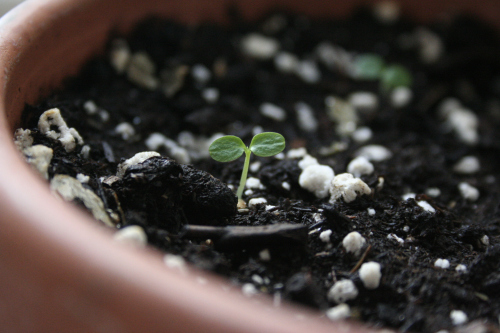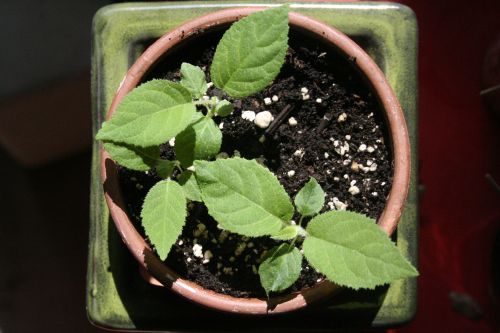Kiwifruit is so tasty; it’s intoxicating. All my life, I’ve enjoyed the unique flavour and texture of kiwis but never stopped to wonder where they come from and how they grow. It took 24 years, countless fruit salads, and the digestion of numerous tiny black seeds before I thought about planting some.
After my first kiwi sprouts emerged from the soil, I did some research and realized that Canada, with its uncomfortably cold winters, is not an ideal environment for growing kiwi plants. While fairly hardy, kiwi cannot survive temperatures below -18 degrees celsius.
This news didn’t; however, change my mind about continuing to care for my seedlings. I find watching their development fascinating and enjoy seeing them grow into beautiful little vines. Plus, judging by the way our climate has been changing in recent years, it may soon become possible for kiwi to survive a southern Ontario winter. Whether you’re planting to observe or to consume, here’s how you can get growing your own kiwi vines…
Things you’ll need…
1) A kiwi. Try to get an organic kiwi in order to avoid the possibility that non-organic seeds may not reproduce as well. There are a few different types of kiwifruit in existence and this step-by-step method for sprouting should work for all varieties…

2) A small mug or container. This will hold your kiwi seeds for their first week of germination.
3) Paper towels, a plate, and a clear plastic container. These will be used to construct a very simple mini greenhouse for germinating your kiwi seeds.
4) Potting soil. I would guess that any potting soil will do, but I suggest using one with a blend of peat, perlite, vermiculite, and organic fertilizer. Almost all of the seeds I planted in this type of certified organic potting mix have sprouted beautifully, so I think it’s fair to say that it works.
5) Containers/pots. A container (with drainage holes) that is 2-3” deep and an inch or two in diameter will be sufficient for sprouting; however, the seedlings will eventually need to be re-potted into larger containers in order to continue growing. The size of the container is up to you, but I suggest a rather large pot since kiwi vines get quite big and re-potting intertwined vines is not always a simple task.
6) Sun, or a grow light. Kiwi vines need lots of light, especially when sprouting. If you don’t have enough natural sunlight you will likely need to supplement some of it with a grow light.
Method for sprouting kiwi seeds…
1) Scoop some kiwi seeds out of your ripe, organic kiwifruit and clean them by rinsing off all of the fruit. I found that placing them in a small cup, adding water, swishing them around in it and then carefully straining the water out was the easiest way to accomplish this. Do this a few times until they are completely clean.
2) Fill your small mug or container with lukewarm water and add your kiwi seeds. Place them in a warm location, such as in front of a heater, on top of a computer, or on a warm window sill. Your kiwi seeds will remain in this water-filled mug until they start to open (for about one week), so I suggest changing the water once a day in order to avoid unwanted bacteria growth…
3) Once you can see the seeds beginning to open, it’s time move them to their mini greenhouse. Soak some paper towel with lukewarm water and place it on a plate. Distribute your germinating seeds on the paper towel, cover them with a plastic container and place them in a warm, sunny spot. (Make sure you poke some holes in the plastic container in order to allow for some airflow). Your seeds will sprout fast in these conditions. After only two days of life in their greenhouse, my kiwi seeds were ready for planting…

4) As soon as you’re seeds are sprouted, it’s time to plant. Before planting, always prepare your container well. Pre-moisten your potting soil by putting some soil into a bucket and mixing in some water until it is damp all the way through…

5) Fill your container with the pre-moistened soil. Leave about an inch of space below the rim of your container.
6) Plant your seeds! Sprinkle your seeds into one or more pots making sure they are at least a few inches apart. I suggest giving each seed its own small pot in order to make transplanting easier; however, I split seven sprouted kiwi seeds between two pots and they are all growing fine. Once they are in their pot(s), cover them with a thin layer of soil. I’ve read that all seeds should be planted at a depth of about twice their length, so you can imagine just how little soil is necessary to cover your kiwi seeds.
7) Once planted, water thoroughly with a squirt bottle or gentle watering can and place your pot or container in a warm, sunny, location (for some, this may mean under a grow light). If you feel that your house may be too cold or drafty for the little guys to continue germinating, cover the top of your pot(s) with clear plastic with holes punched into it and secure with an elastic band. This will continue the greenhouse effect and can be left on until you see your sprouts emerge from the soil…


8) Take care of your fuzzy babies and enjoy the process. Provide them with:
- Water. Ensure that the soil is damp at all times, especially when your kiwi sprouts are young. Do not allow them to sit in a puddle of stagnant water though; those drainage holes are there for good reason.
- Sunlight. Ideally, they should be placed in a warm sunny window where they will receive plenty of direct sunlight each day. If a consistently sunny window is not possible, supplement some sun for a grow light. Since Toronto rarely seems to get any sun in the winter, my sprouts reside under the warm rays of a grow light for 12 hours each day. Once they get a bit bigger, I will move them outside for the summer months.
- Food. In order to keep your kiwi vines healthy and growing, the soil will eventually need to be replenished with nutrients. I suggest feeding it an organic fertilizer, such as compost or vermicompost, once it has developed a nice little set of leaves. Dig a little trench around the base of your vines, fill it with compost and water it well. Or, serve it up as compost tea. Try feeding your vines a few times each year or as needed, but do not overfeed! When it comes to fertilizing, less it best; so if in doubt, put it off a bit longer. (Another option is to start your seeds in potting soil with vermicompost or worm castings mixed into it).
- Love. Spend some time looking at your fuzzy new friends. Get into the habit of watching for browning leaves and checking the underside of leaves for pests. Just like us, our plants can fall victim to bugs and disease and may sometimes require some extra love and affection (via GrowingWildCeeds).
If you like this idea, be sure to share it with your friends and inspire someone you know. Anything becomes possible with just a little inspiration…


